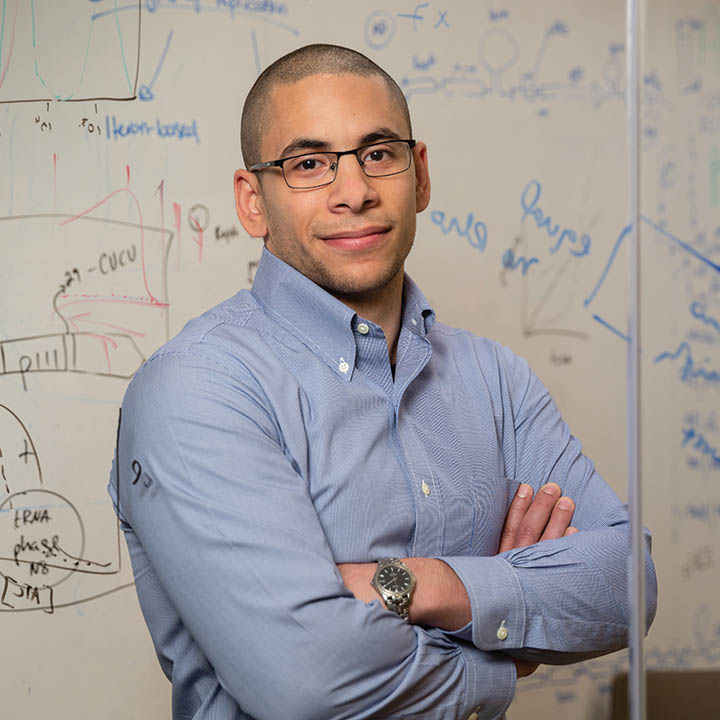Protein engineering, autism genetics and virology experts join the faculty, and a Scripps Research Fellow is promoted to assistant professor, in pursuit of new knowledge and treatments for unmet medical needs.
Four scientists joining the widely respected Scripps Research faculty bring a diverse set of new methods and tools, with expertise in subjects ranging from protein engineering to the gene expression patterns of autism to innate immunity to RNA viruses.
“We are incredibly fortunate to continue to hire young colleagues that are at the forefront of their fields. They bring new technologies and ideas to complement the existing bedrock of our talented faculty,” says Jamie Williamson, PhD, executive vice president of Research and Academic Affairs at Scripps Research. “The future of Scripps Research is very bright, and I look forward to seeing the exciting programs from this new cohort develop in the coming years.”

(Photo credit: Casey Atkins; Courtesy: Broad Institute)
Ahmed Badran, PhD
Formerly a fellow and principal investigator of the Broad Institute of MIT and Harvard, Ahmed Badran, PhD, will join the Scripps Research Chemistry Department as an assistant professor. Badran’s lab is actively developing methods for the high-throughput study of ribosomes, the cell’s protein-building machinery. He’s also working to use ribosomes to build proteins never before seen in nature, to facilitate production of new medicines, probe mechanisms of antibiotic resistance, and more.
Badran studied biochemistry and molecular biophysics, alongside molecular and cellular biology, at the University of Arizona. Under the mentorship of Indraneel Ghosh, PhD, he pioneered approaches for rapid detection of researcher-defined DNA sequences, quantification of messenger RNA, and assessment of nucleic acid damage. Subsequently, he earned his PhD in chemical biology from Harvard University under the mentorship of David Liu, PhD, where he focused on developing and applying rapid methods for continuous directed evolution. His research enabled the prediction of antiviral drug resistance, improved the specificity of genome editing reagents and overcame mechanisms of insecticide resistance.
Upon completing his doctoral studies, Badran started an independent research group at the Broad Institute. There, his lab developed technologies to define pathways of ribosome assembly in living cells, created genetic codes capable of encoding complex information, and explored how horizontal gene transfer can influence the evolution of proteins.
Badran has been the recipient of multiple awards. These include the Arnold and Mabel Beckman Scholarship, the Bio5 Innovator Award, the Galileo Circle Scholarship, a National Science Foundation (NSF) Graduate Research Fellowship, the Christensen Prize for Outstanding Research Achievement, and the Harvard Graduate School of Arts and Sciences (GSAS) Merit Fellowship. A finalist for the Reaxys PhD Prize, he was also awarded the National Institutes of Health Director’s Early Independence Award.
Badran says his lab will focus on understanding the fundamental processes at play during protein translation, and harnessing that understanding to address diverse problems ranging from the need for new antibiotics to the challenge of how to sequester greenhouse gases.
“Scripps Research is a leader in biomedical research with a focus on innovations in both clinical and biotechnological settings, bolstered by pioneers in chemical biology and drug discovery,” Badran says. “These points collectively make it an exceptional fit for me and my lab, and we’re thrilled to be joining this community.”
Sumit Chanda, PhD
The pandemic coronavirus, influenza, dengue, West Nile and HIV infect different cells and hence cause very different illnesses. But all store their genetic material in ribonucleic acid, or RNA, and activate similar innate immune defenses.
The newest faculty member to join Scripps Research, Sumit Chanda, PhD, is an expert on innate immunity to RNA viruses. Chanda not only studies how RNA viruses infect cells, and how the immune system responds, he uses the information to identify potential medicines. He has quickly become an authority on SARS-CoV-2, the cause of COVID illness.

Chanda joins the Scripps Research Department of Immunology and Microbiology as a full professor and also shares time at Calibr, the institute’s drug discovery and development division.
“One of the driving forces for me coming to Scripps Research is really to be able to put a medicine into humans,” Chanda says. “Scripps Research is really unique in that it has the infrastructure and expertise to channel discoveries into moving the needle on human health.”
Chanda has been a frequent collaborator with Scripps Research scientists, including those at Calibr, during the pandemic. They worked together to identify existing drugs that may be able to boost the effectiveness of current treatments for COVID infection. Chanda has also discovered an immune factor in the lungs that, upon infection with SARS-CoV-2, ignites a wider immune attack.
Chanda has produced major advances in other areas of infectious disease as well. He helped discover how HIV suppresses the innate immune response. And recent work on influenza highlighted a mechanism that makes the H5N1 “bird flu” strain more effective at infecting cells that shrug off other seasonal flu strains, important to understand for future pandemic preparedness.
Chanda earned his doctorate in molecular pharmacology from Stanford University in 2001. He says studying in Silicon Valley embedded an ideal of improving scientific methodology with technological innovations. To that end, he is the founder of a widely used open-source tool for annotating genes, called metascape.org.
From Stanford, Chanda joined the Genomics Institute of the Novartis Research Foundation, where he went on to lead his first research group in its Division of Cellular Genomics. He joined Sanford-Burnham Medical Research Institute in 2007. Since 2015, he directed its Immunity and Pathogenesis program.
“It’s not an ‘if’ but a ‘when’ that the next pandemic will occur. Hopefully we as a planet will be better prepared,” Chanda says. “Working with the people at Scripps Research, there is an opportunity for me to help achieve that goal.”

Xin Jin, PhD
The interaction of genetics and physiology in brain development fascinates Xin Jin, PhD, who joins the Scripps Research Neuroscience Department as assistant professor following her junior fellowship at the Harvard Society of Fellows and the Broad Institute. Jin has developed and applied genetic engineering and genomic tools called in vivo Perturb-seq to probe at scale how autism risk genes impact a variety of cell types. Her techniques allow for observation of the effects of each genetic mutation in millions of single cells in vivo, providing insights at unprecedented resolution of how diverse mutations affect brain development.
While earning an undergraduate degree in chemistry at MIT, Jin worked in the labs of Scripps Research chemist Ben Cravatt, PhD, and MIT chemist Alice Ting, PhD. She went on to earn her doctorate in biology at The Rockefeller University, working in the lab of Cori Bargmann, PhD.
Over the course of her studies, she earned multiple awards and fellowships. She received the Simons Foundation Collaborative Grant, a Young Investigator Award from the Brain and Behavior Research Foundation, an Allison Doupe Fellowship from the McKnight Foundation, an Intersections Science Fellow Award, a Presidential Member Award from the Genetics Society of America, and a Howard Hughes Medical Institute (HHMI) International predoctoral fellowship for graduate work.
Jin says she’s thrilled to return to Scripps Research. Her lab will focus on building and applying a suite of new neuro-technologies to study brain development and disorders.
“Here at Scripps Research, chemists and biologists talk to each other, and true interdisciplinary research happens,” Jin says. “This inspires us to connect genomic technologies with new insights into how these complex inputs are integrated into the brain or misinterpreted in the disease context. I am excited to learn from this diverse and energetic scientific community and contribute to it.”
Danielle Grotjahn, PhD
Also joining the faculty is former Scripps Research Fellow Danielle Grotjahn, PhD. An assistant professor in the Department of Integrative Structural and Computational Biology, Grotjahn studies the interplay
of mitochondria, the cell’s energy organelles, and their surrounding cellular environment, especially in response to cellular stress. She employs advanced structural and computational tools including cryogenic electronic microscopy.

Previously, Grotjahn completed a postdoctoral position at the California Institute of Technology. She earned her doctorate at Scripps Research where, under the mentorship of structural biologist Gabe Lander, PhD, she helped solve the first three-dimensional structure of the dynein complex bound to microtubules.
Among many awards, she is a recipient of the Damon Runyon-Rachleff Innovation Award, the Harold M. Weintraub Graduate Student Award, an Achievement Rewards for College Scientists (ARCS) Foundation fellowship, and National Science Foundation (NSF) Graduate Research Fellowships.
Grotjahn says the collegial and supportive atmosphere at Scripps Research makes it an ideal place to establish her research program.
“The most exhilarating aspect of my research is truly being the first to explore and see inside of cells in a completely new way,” Grotjahn says. “I am excited to continue discovering structural secrets and identifying key interactions that lead to disease pathogenesis.”